Buy AutoTrafficRSS script now for $27 only!
We will send the script to your PayPal email within few hours,Please add FullContentRSS@gmail.com to your email contact.Source: How to install #WordPress locally on #Windows 10 without 3rd #Party apps
Buy AutoTrafficRSS script now for $27 only!
We will send the script to your PayPal email within few hours,Please add FullContentRSS@gmail.com to your email contact.There are lots of factors that determine the success of business blogging. One of those factors takes place even before building a blog for your business.
Choosing the platform where to host your blog is important as it serves as the foundation where your blog rests.
Therefore, it is crucial that you get selecting a blogging platform right the first time. If you feel that you have chosen wrong, you will need to undergo a painstaking process of transferring all your content from your old blogging platform to a new one.
This goes by also saying that there is no single perfect platform for everyone; rather, there is only a blogging platform that works best for you.
In this post, we will discuss the follow criteria to determine the best blogging platform that suits your business.
Related Article: Small Business Blogging: 5 Reasons It Works & Tips for Execution
User-FriendlinessNot all businesses have the funds to get someone to build the blog for them nor the skills and patience to set up a self-hosted blog for his or her companies. They prefer a quick and easy DIY platform where they can build a blog on the go without the fancy features known from another platform.
This is the reason why website builders exist. Not only can businesses build a beautiful website for their products and services to attract their audience and convert them into customers, but they can also create a content-rich blog that their target market would want to read. The key to the success of website builders is their drag and drop feature that allows website and blog owners to include elements on a site page easily without any design skills or experience.
One of the best and most popular website is Weebly. Perfect for small business and E-commerce sites, the platform takes away the guesswork from site building by allowing you to drag easily and drop website elements and bring your ideas to life. Here is a great review and tutorial about Weebly for your pleasure.
PowerfulOne of the many quirks that people do not like about website builders is the limited nature of the platform. Given that it is built for beginners due to this drag and drop feature, the platform provides little to no room for customization. As a result, there is a tendency for users of website builders to have to the same look and feel on their business blogs.
To truly stand out, you would want a platform that will afford you a customized appearance for your blog to help it stand out from its competition. A platform like a self-hosted WordPress blog ought to do the trick.
There is an excellent reason why almost half of the sites online use WordPress to run their blog, which is also the reason why I believe that this is arguably the best platform to use for your blog. Aside from customization, WordPress lets you supercharge your blog with thousands of plugins to choose from to help you achieve your business goals. Whether it is building your email list, selling your products and services, or engaging with your readers, WordPress has the plugin that you need.
To help you create a website using WordPress, this resource site will give you the details on how to make a beautiful looking blog in a couple of minutes.
Related Article: 5 Costly Blunders That Could Compromise Your Blog in 2016
Responsive and Mobile-FriendlyWith the rise of mobile use to search the web, there is now need to build websites that are optimized for mobile viewing. Your blogging platform should have the ability to resize the page automatically depending on the screen resolution of the user browsing your blog, whether it is a desktop or a mobile device. With a responsive design for your business blog, you can ensure that your site loads fast on any device and prevent visitors from leaving your site due to slow loading speed.
Therefore, building a blog using Joomla is an excellent way to leverage the ability to provide a mobile-friendly design to deliver your blog content. Arguably one of the most professional platforms in the market, there is a lot to love about Joomla other than its mobile-readiness, which is clearly stated in this resource post.
Third-Party IntegrationAs a business blogger, you will want all the help you can get. This means getting different service providers to integrate with your choice of platform. Similar to WordPress plugins, Drupal's modules allow you to get the most out of your blog and bring it to the next level with added features. If you want to boost your social media activity, CRM, SEO, and security feature, Drupal has something for everyone. Check out other benefits of choosing Drupal as your blogging platform in this post.
SimplicityLet's face it - most of the blogging platforms out there are focused on providing the full-scale experience of designing, developing, and boost their blogs that it is easy to forget what a blog is all about, which is sharing ideas with readers through your content. If you simply want to focus on harnessing the power of the written word, then you may want to forego the platform mentioned above and go straight to a no-frills platform like Ghost.
Ghost brings back the "blogging" in blogging platform. It lets you build your blog around your content, which is the focus of the platform. You can customize the look and feel as you see fit, although you may need help from a developer to achieve the appearance you want. Nonetheless, this should not scare you if your primary focus is to blog and let your words do the talking.
In case you need more convincing to try out Ghost, here is a post to help get you to try out this platform.
Related Article: Stay In the Know: How to Keep Up with Digital Marketing Trends
ConclusionGiven that you have been presented with not only different criteria to consider when choosing a blogging platform as well as the actual platforms themselves, but it is also time for your to test-run them yourself and see which one you are most comfortable using. The criteria should help you determine your priorities as a blogger using their platforms. From there, you can decide the perfect blogging platform for you.
Buy AutoTrafficRSS script now for $27 only!
We will send the script to your PayPal email within few hours,Please add FullContentRSS@gmail.com to your email contact.Jack of all trades, master of none. Growing up, this was our greatest fear – nobody wanted to be Jack. So we decided to play it safe and stick to the one thing we knew we were good at, and in the process of 'one-mind success', we subconsciously closed off other potential options. We may be round the clock workers, pooling in extra hours to ensure we get that fat paycheck at the end of the month. But, are we truly happy with just that to show for ourselves?
As humans, we intrinsically crave for more than what we're getting because we realise out true inbuilt potential. But managing two or more concrete jobs is no piece of cake, so we retreat with our tails between our legs and perch ourselves in front of our computers – efficiently computing the task assigned to us.

But today, we can pen down our passions while on the day job – by blogging. Be it through WordPress or Blogger, blogging gives you the perfect platform to carry out a Plan B and make it a part of your professional day to day life. All it takes is a couple of hundred words and some great penmanship!
But maintaining a full-time job as well as a professional blog isn't easy. More often than not, people start to lag on the latter and miss out on what can truly be one of the smartest investments they can make.
To help you sort out this dilemma, we present you with a few tips to maintain your blog while still working a full-time job.
Sort out your nicheIt's very natural to treat your blog like a public journal and type out any and every wayward thought that crosses your head. But that's confusing and a hassle to follow and that's where you lose out on half your followers and waste eons of precious time. Before you launch your blog, it would be wise to peter down to one chosen niche on which you can continue to work on for the next couple of blog posts and one that is sure to get you a good readership and following.
Determine your target audienceThe second most important thing to do is to figure out the target audience that suits your niche. You don't want to be putting up deep philosophical mumbo jumbo out to the world and have that one lone follower who also happens to be your best friend. Put out a couple of experimental content first, see the response you get and also which demographic gives you the best response. Start creating content based on these statistics and shell out your work for a wider reach!
Check your analyticsSharing posts on Facebook and Twitter and getting a base number of likes and shares does not reflect your reach to a wider set of audience. WordPress gives you the option to check the percentage and number of views to your posts, individually. Based on this, you can tell which ones fare better than the other. According to these statistics, you will be able to judge what kind of content plays to your advantage.
Keep postingEven if you think it isn't your best quality work and the words are still a bit jumbled, keep posting, because the minute you lag, your viewership will drop, as will your desire to keep shelling out more content. It's very easy to fall into a lethargic web and give up blogging as a 'hobby', but enough content has been put out in the corners of the internet about how you can monetise your blog and set up a flourishing business out of it. So don't stop writing. It's your very legacy.
StrategiseThis is the final, and possibly most crucial, part of the entire process that distinguishes your blog from between being professional or simply being a past-time. Chalk out a plan at the beginning of every week, figure out how many posts you want to put out on a daily basis and how you can promote them instantly. Use social media to its maximum potential. Once you have your requisite following, approach investors and marketers, and form a symbiotic relationship with them. Tell them that you will grant them ad space in return for their investment and ordeal on a successful business relationship, one that does not encroach onto your daytime business in any right or form.
These are the five easy steps to help maintain an active blog primarily for a professional purpose, while keeping up with your daily full-time job. Some days may be harder than others, considering the unpredictability of work hours and shifts. But more importantly, this is a steady and fairly simple mantra to follow and excel at. So start writing, folks!
Home » WordPress Plugins » Utilities » Fresh File Editor – WordPress Plugin
Demo: https://codecanyon.net/item/fresh-file-editor-wordpress-plugin/7830856
Created 25 May 14 Last Update 5 August 14 High Resolution Yes Compatible Browsers IE8, IE9, IE10, IE11, Firefox, Safari, Opera, Chrome Files Included JavaScript JS, CSS, PHP, LESS Software Version WordPress 4.0, WordPress 3.9 Tags admin, browser, child theme, code, css, edit, editor, explorer, file, fresh, ftp, system, text, tree, wordpress Fresh File Editor – WordPress PluginFree Download Links Please Disable Your AdBlockLinks will be visible once you whitelist UnlockPress.com on your adblocker.
It's our way of surviving and your way of supporting us.

http://www.mirrorcreator.com/files/0SWXUVA5/http://www109.zippyshare.com/v/vIsvlRir/file.htmlhttp://uploaded.net/file/forbidden/freshfileeditor10_0.rarhttp://www.solidfiles.com/d/aWz5W3ZV7nNvQhttp://hugefiles.net/csff246krnvahttp://www.filefactory.com/file/43tlyj06f8vb/freshfileeditor10_0.rarhttps://tusfiles.net/lavr7e6yi4myhttp://uppit.com/a2q95jj44lkfhttps://userscloud.com/4uhkryt8l4no
AboutEasily Add, Rename, Delete and Edit your server files via WordPress admin without any FTP and Text Editor apps
Ace Editor + EmmetProfessional Ace text editor with Emmet toolkit which lets you write your HTML or CSS code faster by expanding abbreviated HTML tags and CSS properties into their full form. More info can be found in their own cheatsheet (scroll down to HTML or CSS section). To quickly try Emmet, open any .CSS file and type bgc into the editor and hit TAB key. It should expand to background-color
Main FeaturesResponsive Multi-Purpose Parallax WordPress Theme – BigStream
Responsive Multi-Purpose Parallax WordPress Theme – Milo
Buy AutoTrafficRSS script now for $27 only!
We will send the script to your PayPal email within few hours,Please add FullContentRSS@gmail.com to your email contact.Buy AutoTrafficRSS script now for $27 only!
We will send the script to your PayPal email within few hours,Please add FullContentRSS@gmail.com to your email contact.There are lots of factors that determine the success of business blogging. One of those factors takes place even before building a blog for your business.
Choosing the platform where to host your blog is important as it serves as the foundation where your blog rests.
Therefore, it is crucial that you get selecting a blogging platform right the first time. If you feel that you have chosen wrong, you will need to undergo a painstaking process of transferring all your content from your old blogging platform to a new one.
This goes by also saying that there is no single perfect platform for everyone; rather, there is only a blogging platform that works best for you.
In this post, we will discuss the follow criteria to determine the best blogging platform that suits your business.
Related Article: Small Business Blogging: 5 Reasons It Works & Tips for Execution
User-FriendlinessNot all businesses have the funds to get someone to build the blog for them nor the skills and patience to set up a self-hosted blog for his or her companies. They prefer a quick and easy DIY platform where they can build a blog on the go without the fancy features known from another platform.
This is the reason why website builders exist. Not only can businesses build a beautiful website for their products and services to attract their audience and convert them into customers, but they can also create a content-rich blog that their target market would want to read. The key to the success of website builders is their drag and drop feature that allows website and blog owners to include elements on a site page easily without any design skills or experience.
One of the best and most popular website is Weebly. Perfect for small business and E-commerce sites, the platform takes away the guesswork from site building by allowing you to drag easily and drop website elements and bring your ideas to life. Here is a great review and tutorial about Weebly for your pleasure.
PowerfulOne of the many quirks that people do not like about website builders is the limited nature of the platform. Given that it is built for beginners due to this drag and drop feature, the platform provides little to no room for customization. As a result, there is a tendency for users of website builders to have to the same look and feel on their business blogs.
To truly stand out, you would want a platform that will afford you a customized appearance for your blog to help it stand out from its competition. A platform like a self-hosted WordPress blog ought to do the trick.
There is an excellent reason why almost half of the sites online use WordPress to run their blog, which is also the reason why I believe that this is arguably the best platform to use for your blog. Aside from customization, WordPress lets you supercharge your blog with thousands of plugins to choose from to help you achieve your business goals. Whether it is building your email list, selling your products and services, or engaging with your readers, WordPress has the plugin that you need.
To help you create a website using WordPress, this resource site will give you the details on how to make a beautiful looking blog in a couple of minutes.
Related Article: 5 Costly Blunders That Could Compromise Your Blog in 2016
Responsive and Mobile-FriendlyWith the rise of mobile use to search the web, there is now need to build websites that are optimized for mobile viewing. Your blogging platform should have the ability to resize the page automatically depending on the screen resolution of the user browsing your blog, whether it is a desktop or a mobile device. With a responsive design for your business blog, you can ensure that your site loads fast on any device and prevent visitors from leaving your site due to slow loading speed.
Therefore, building a blog using Joomla is an excellent way to leverage the ability to provide a mobile-friendly design to deliver your blog content. Arguably one of the most professional platforms in the market, there is a lot to love about Joomla other than its mobile-readiness, which is clearly stated in this resource post.
Third-Party IntegrationAs a business blogger, you will want all the help you can get. This means getting different service providers to integrate with your choice of platform. Similar to WordPress plugins, Drupal's modules allow you to get the most out of your blog and bring it to the next level with added features. If you want to boost your social media activity, CRM, SEO, and security feature, Drupal has something for everyone. Check out other benefits of choosing Drupal as your blogging platform in this post.
SimplicityLet's face it - most of the blogging platforms out there are focused on providing the full-scale experience of designing, developing, and boost their blogs that it is easy to forget what a blog is all about, which is sharing ideas with readers through your content. If you simply want to focus on harnessing the power of the written word, then you may want to forego the platform mentioned above and go straight to a no-frills platform like Ghost.
Ghost brings back the "blogging" in blogging platform. It lets you build your blog around your content, which is the focus of the platform. You can customize the look and feel as you see fit, although you may need help from a developer to achieve the appearance you want. Nonetheless, this should not scare you if your primary focus is to blog and let your words do the talking.
In case you need more convincing to try out Ghost, here is a post to help get you to try out this platform.
Related Article: Stay In the Know: How to Keep Up with Digital Marketing Trends
ConclusionGiven that you have been presented with not only different criteria to consider when choosing a blogging platform as well as the actual platforms themselves, but it is also time for your to test-run them yourself and see which one you are most comfortable using. The criteria should help you determine your priorities as a blogger using their platforms. From there, you can decide the perfect blogging platform for you.
Buy AutoTrafficRSS script now for $27 only!
We will send the script to your PayPal email within few hours,Please add FullContentRSS@gmail.com to your email contact.WordPress is the most popular content management system for blogging on the web by a long margin. Unfortunately, this has made it a target for nefarious hackers looking to access private data and/or insert malware. This infographic from cmstowp breaks down everything you need to know about WordPress security — including tips to keep your site protected.
cmstowp is a CMS migration service provider and builder of custom web applications. Its infographic on WordPress security contains a solid overview on the topic, along with effective management tips and warning signs to look out for.
[Via cmstowp]
Since WordPress is one of the most popular platforms for blogging, it makes it's a preferred target for hackers who are continuously in search of finding novel ways and means to exploit the potential weaknesses in websites.
Effective management of your WordPress site is a more than a necessity and maintaining its health and privacy at all times is a must.
Persistent monitoring and keeping an eye on the security not just helps to safeguard the website from unwanted attacks but also regulates right functioning.
The below infographic depicts some of the symptoms that you can watch out for while managing your WordPress site.
Once you identify the influencing factors behind the mediocre performance of your site, you can define measures to fix them.
Keeping a strict vigilance, over the period, would ensure taking preventive steps beforehand.
Have you subscribed to Lifehacker Australia's email newsletter? You can also follow us on LinkedIn, Facebook, Twitter and YouTube.Buy AutoTrafficRSS script now for $27 only!
We will send the script to your PayPal email within few hours,Please add FullContentRSS@gmail.com to your email contact.Switching WordPress to HTTPS, meaning an SSL certificate, is often determined as being difficult on the internet. However, as always when it comes to things said on the web, be careful. The truth is that it is rather easy, and everyone that has at least some experience with WordPress, and can install the CMS can do it. In this article, I'll guide you through each necessary step, one by one.

In this article, we'll assume that the SSL certificate has already been assigned to your domain by the web host. For over 90 percent, this should be the case. Only your own dedicated server will have you do this work. This shouldn't be a problem, however, as it's pretty easy.
The only more complicated thing is the creation and allocation of a free Let's Encrypt certificate. However, I'll assume that a proper, paid https is used. At my host, this only costs 23.90 EUR a year and is immediately assigned to the domain.
Step 1: Login Into the WordPress Admin AreaAfter logging in, go to the menu item "Settings => General" and change the two entered addresses to the HTTPS version. You only need to add the lower case "s."
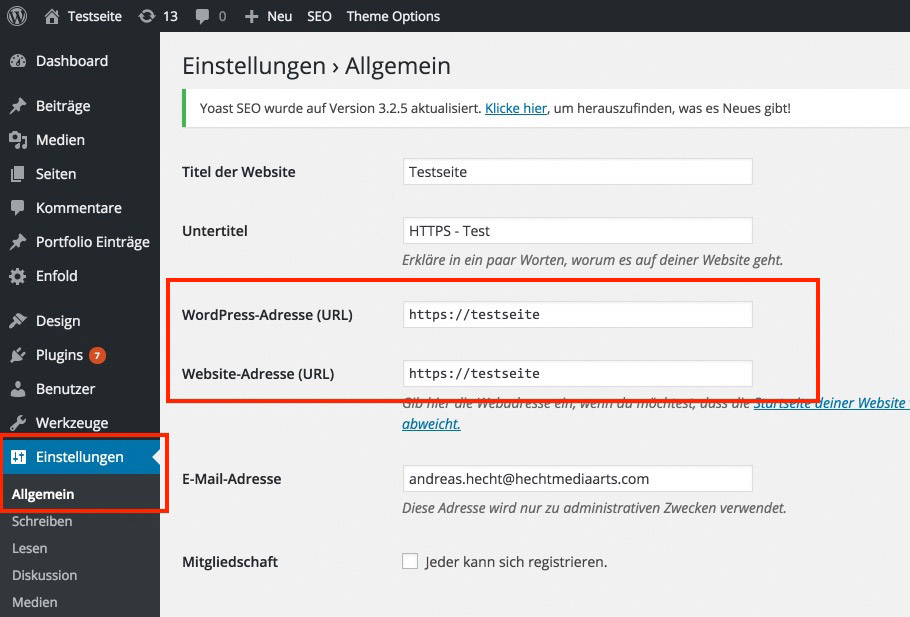
If that doesn't work for you, there's another way to shift the WordPress addresses. Log into your web hosting package or server via (S)FTP, and add the following code to the wp-config.php
Copy and paste the following code below the table prefix, save, and reupload the file. Now, you have gained access to your website via HTTPS.
Schritt 2: Overwriting All URLs in the DatabaseThe dynamic URLs, like the ones of the scripts and files, are already accessible via HTTPS. Now, it's about shifting the static URLs of the images in the articles to SSL as well. For that, you could use a plugin, but it's more comfortable and safer to use the Database Search and Replace Script by interconnect/it.
However, before using the script, please create a complete database backup in phpMyAdmin. You never know…
Script Download and Call-UpDownload the script folder, unzip it, rename it to "replace", and load the entire folder (not just the files!) into your WordPress installation's root index. Now, call up the script by entering your domain followed by the word replace into your browser's address bar.
https://yourwebsite.com/replace
After that, you should be able to see the script.
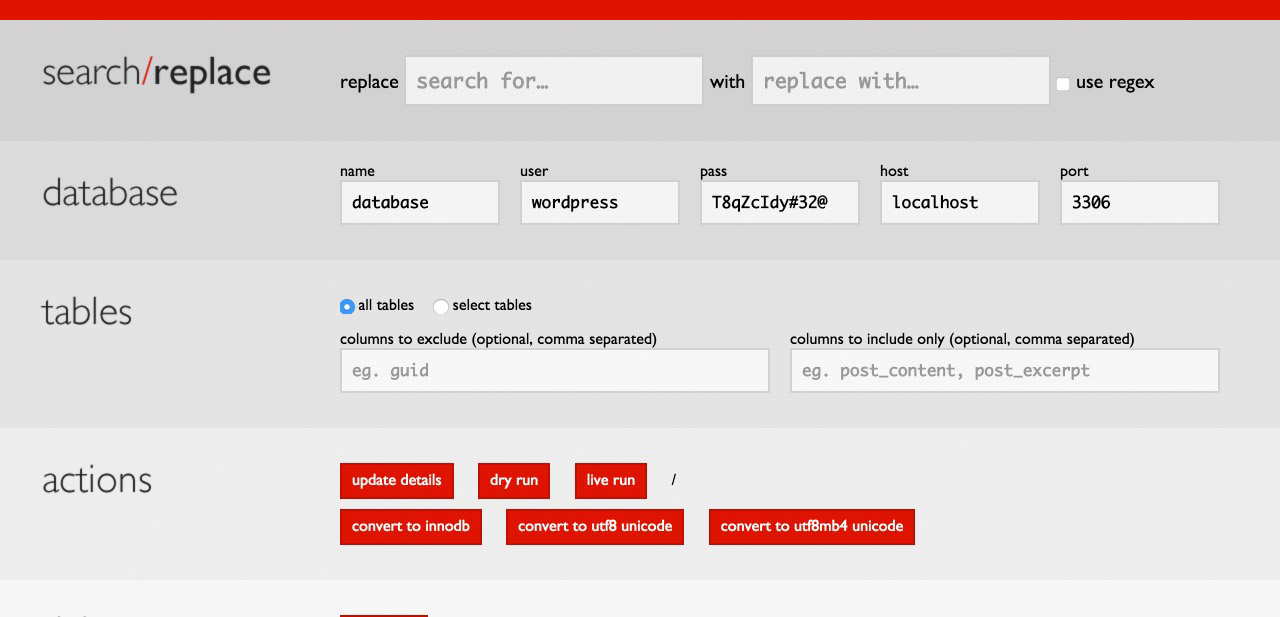
The access information of your database is already entered, you only need to enter your old URL in the upper left input field, and the HTTPS version on the right. Other settings are not required. A click on "live run" then changes the URLs in the database.
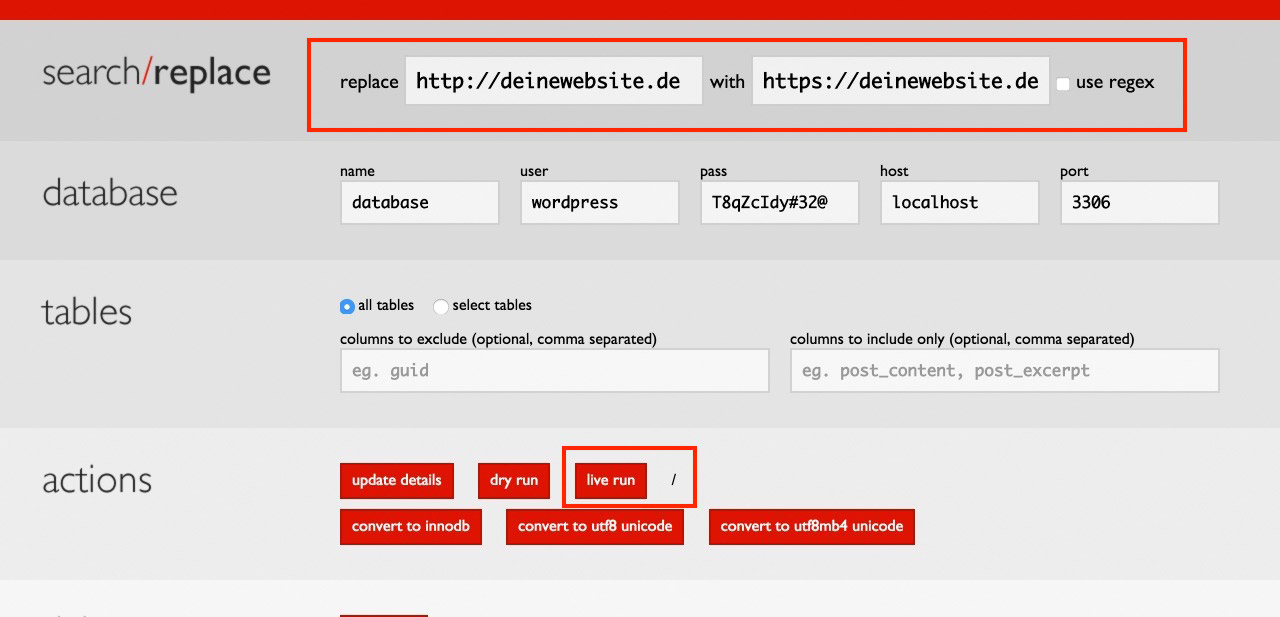
The script will realize the required entries in a rather short amount of time. An error message may pop up, as the script attempts to increase the execution time and the PHP memory limit. Just ignore these notifications.
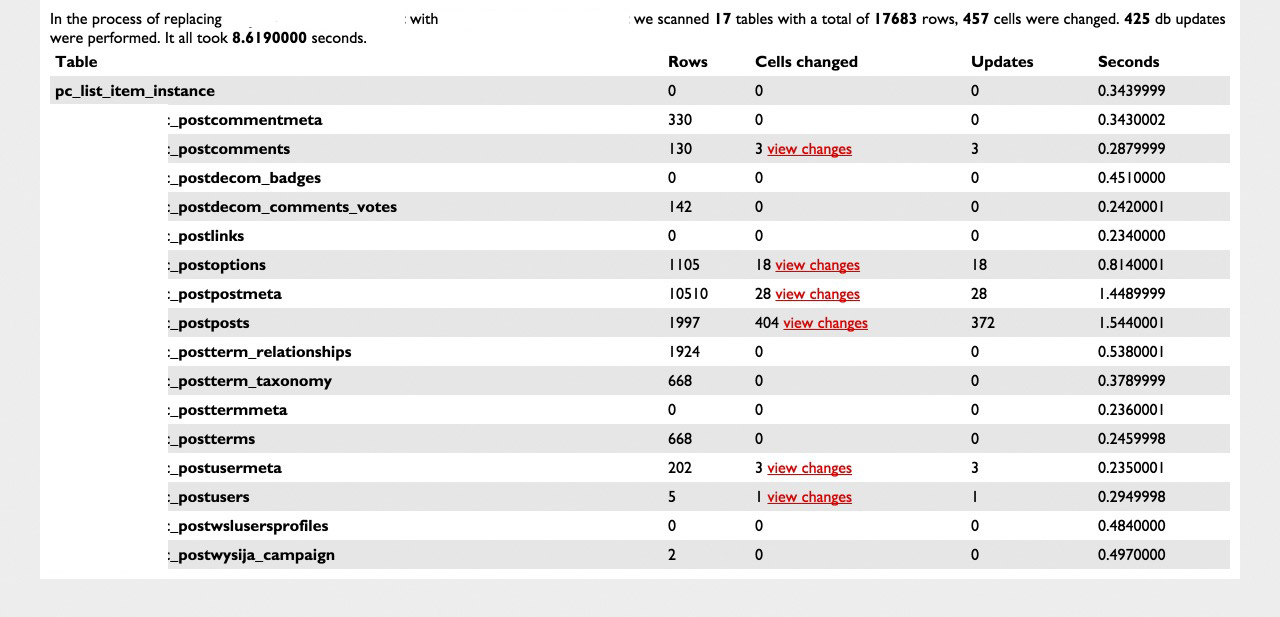
The Success Notifications. All Tables Have Been Altered Successfully.
As soon as this step is done, scroll down in the script until the "Delete" button becomes visible, and click it. The folder with the script will then be deleted from the server, as it poses a large security risk.
Step 3: Changes to the htaccess File and the wp-config.php.htaccess
In this final step, the .htaccess file is extended by an important aspect. The following code will cause a constant 301 redirection of the HTTP to the HTTPS version of your website. The website will only be accessible via HTTPS, and on top of that, the code will notify Google that there is no HTTP version of your website anymore.
wp-config.php
This code snippet has to be placed in the wp-config.php of your WordPress, below the table prefix.
Then, login is only possible via the HTTPS version.
The Final ResultYou should now see a green version on the landing page and all articles.
![]()
However, it is possible that there are still files coming from HTTP. Then, the lock will either display in gray, or the resources will be blocked by the server. The menu item console in the developer tools of your browser will inform and show you the resources that are not encrypted.

Most of the time, you have integrated these files yourself, maybe in the theme's header or footer. This can be helped with an integration of the file with //www.your-file.com, without a prefixed HTTP or HTTPS. Now, the HTTPS version will always be loaded, if possible.
Conclusion:Following this guide step by step, nothing should happen, and the process should be finished successfully in less than an hour. How did it go? Have you already shifted your website to HTTPS?
(dpe)
Buy AutoTrafficRSS script now for $27 only!
We will send the script to your PayPal email within few hours,Please add FullContentRSS@gmail.com to your email contact.WordPress comes loaded with a series of hooks and filters that let you hook into specific parts of when WordPress operates. For example, you can attach a custom function so that it executes when the WordPress save_post action is called, giving you access to the post being saved.
Plugins and themes are an area where hooks are in abundance. Any decent plugin or theme will come with a range of these hooks that they either use internally to operate or expose externally for developers. When a plugin or theme isn't exposed enough you might have issue customizing how it operates.

Generally speaking, the plugins and themes you will run into will be based around Object Orientated Design methods, where one or more classes define how the functionality works. Inside these classes they might define hooks that you want to remove entirely or replace with your own custom functions.
Today were going to dig into WordPress hooks and how you can handle them both in a traditional sense and also when dealing with classes or objects.
Removing Standard HooksWhen hooks and filters are not inside a class they are fairly straight-forward to remove. To remove these hooks you need to use the remove_action function. The basics of this are that you need to supply the following:
When actions hooks are created with do_action it will trigger all functions that have been added to it with add_action as soon as WordPress reaches it.
Example 1: Standard WooCommerce HookLet's look at a visual example. Consider the WooCommerce plugin. When you're on a single page (using the single-product template) you will by default see the breadcrumb bar.

This is outputted via the do_action( 'woocommerce_before_main_content' ); hook. It's purpose is to output the starting content wrapper and the breadcrumbs for the product.

Since we know the name of the action and the function name attached to that hook, we can remove the function entirely as follows.
//remove breadcrumbs from single product remove_action('woocommerce_before_main_content', 'woocommerce_breadcrumb', 20);Now the breadcrumbs will disappear. As long as you know the name of the hook, the name of the function you want to remove and the priority you can remove and replace functions as you see fit. The priority of the hook is important as it has to match the priority used when the function was originally hooked.

When you have actions and filters defined inside classes it can be a little bit tricky. Even though you might know the name of the hook and the name of the function, you won't be able to use remove_action as we did before.
The issue is that if a plugin or theme defines these actions inside of class, those hooks are now attached inside the class. To remove them you will need to pass in the class variable to the remove_action function as follows:
//remove a hooked function from within a call function('hook_name', array($myclass, 'my_function_remove'), 10); So Where Exactly Is the Class Object?This often is the trickiest part. To remove your function you need the class object. To find this you will need to hunt through either the documentation for the plugin or theme (if there is anyway) or alternatively (and less excitingly) searching through their source code to find the variable name.
If the class is a Singleton class, meaning that there should be only one of them at a single time, then you should be able to get the class from using one of the classes inbuilt functions to return the instance of the class such as:
$myClassObject = MyClass::getInstance()
If the class doesn't have a method like that you can try and get the object by calling it globally such as:
global $myClassObject
Since each developer develops differently you might have to search to find the variable you need. Hopefully, if the class has been structured correctly, you should be able to get the object.
If you're trying to remove visual elements outputted you should be able to trace back where it all comes from, for example:
If you're successful you should have the name of the hook and the name of the function you want to remove. All you need is the object itself and you're good to go!
Example 1: Hook Inside WooCommerce ClassLet's look at a practical example so you can see how you'd apply this technique.
Inside of WooCommerce the WC_Emails class is used to generate the output for emails that are sent out (such as the new, processing and completed orders). Inside of WC_Emails the constructor attaches all of the various functions onto hooks to build the output as seen below.
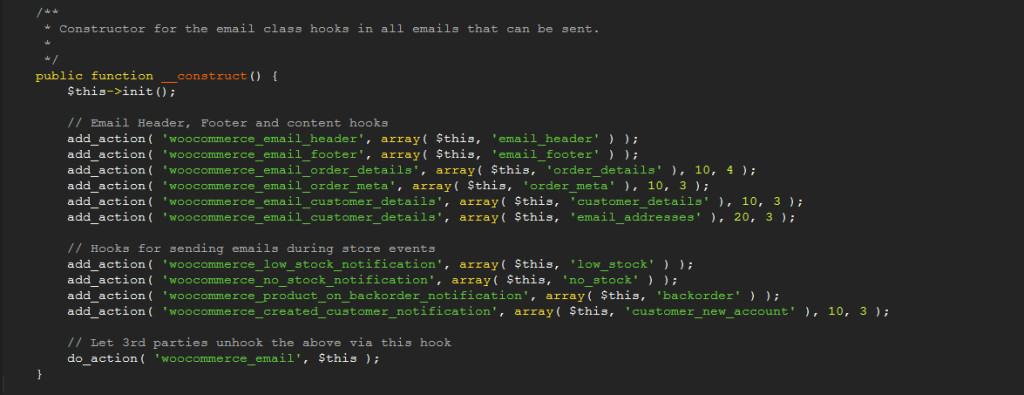
When displaying an email WordPress will hit the woocommerce_email_customer_details hook and will trigger all functions attached to it. When this happens it will trigger the customer_details function defined in the WC_Emails class, outputting the customer details.
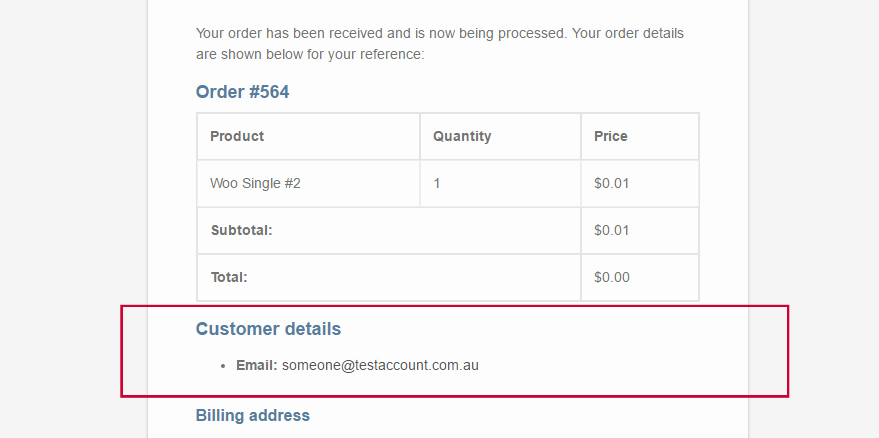
If we didn't want to display these details we would have to remove the customer_details function from the class.
Luckily, at the bottom of the constructor is the woocommerce_emails action that's being called with do_action. We can hook onto there so we can remove our customer details. This hook is passed the object itself via $this so it's perfect for our needs.
//Remove email details from the `WC_Emails` class function remove_customer_email_details($instance) { //remove `customer_details` hooked function remove_action('woocommerce_email_customer_details', array( $instance, 'customer_details'), 10); } add_action('woocommerce_email', 'remove_customer_email_details');We call remove_action and pass in both the $instance and the customer_details function and when we view our emails the customer details have vanished, removed entirely.

In this scenario, WooCommerce left a perfect location for us to hook onto so we could remove these functions. It's up to the plugin or theme developer to place these handy hooks in locations where other developers may need them. That being the case you might struggle removing some functions if the developers haven't thought about it.
Example 2: Hook Inside a Custom ClassWith WooCommerce they have a dedicated team of great developers plus a series of volunteers or contributors continually working to improve their plugin. They've gone through years of development so they know the importance of proving the right hooks so developers can customize things.
In this example, we're going to look at just a simple situation. The idea behind this example is that you can't be guaranteed you will have hooks to rely on and if the developer is even thinking about people extending their work. In this scenario, we're working between a parent and child theme. Inside the parent theme we have our main class and in our child theme we have our additional function.
NOTE: It's useful to point out that remove_filter is the same as remove_action. At the end of the day, they are all a way to removed hooked function and WordPress is happy for you to use them interchangeably.
//A simple test class, loaded directly in your website //Loaded from the parent theme class testClass{ //magic constructor public function __construct(){ add_filter('the_title', array($this, 'wrapTitle'), 10, 1); add_filter('add_extra_word', array($this, 'output_word'), 10, 1); } //wrap the title for each post public function wrapTitle($title){ $html = ''; $html .= '<div class="titleWrap">'; $html .= $title; //append a word to the end of the title $html = apply_filters('add_extra_word', $title); $html .= '</div>'; return $html; } //append the word 'Hello World' to the end of the title public function output_word($title){ $html = ''; $html = $title . ' <strong>Hello World</strong>'; return $html; } } $testclass = new testClass();This class adds a function called wrapTitle onto the the_title hook right in the _construct method. This means that as soon as the class is loaded it will hook that function onto the title and be called every time we're displaying a post. Inside of the wrapTitle function it wraps the current title around a div and then calls the add_extra_word filter.
Back in the constructor we hooked another function called output_word onto the add_extra_word filter. This functions purpose is to add the bolded Hello World text to the end of the title.

As you can see this isn't very attractive. We want to remove this added word from the end of the title. This is the perfect opportunity to remove the function added in the class. Here's how we do it:
//removes the extra word appended to the title (added by the class) //Added to your child theme function remove_extra_word(){ global $testclass; remove_filter('add_extra_word', array($testclass, 'output_word'), 10); } add_action('init', 'remove_extra_word');We first hook our function to be loaded on init. The reason we do this instead of just executing the remove_filter right in the PHP file is because we want it to trigger only once WordPress has started loading. If we declared this function before the class was even loaded it would do nothing (as the class needs to exist first).
We grab a copy of the class by using global $testclass. We do this because this class didn't have any way of giving us our object directly.
Inside the function we now use the remove_filter function and remove the output_word function attached to the add_extra_word action defined in our class.
When this is all done and dusted the Hello World text will be removed and your titles will be back to normal.
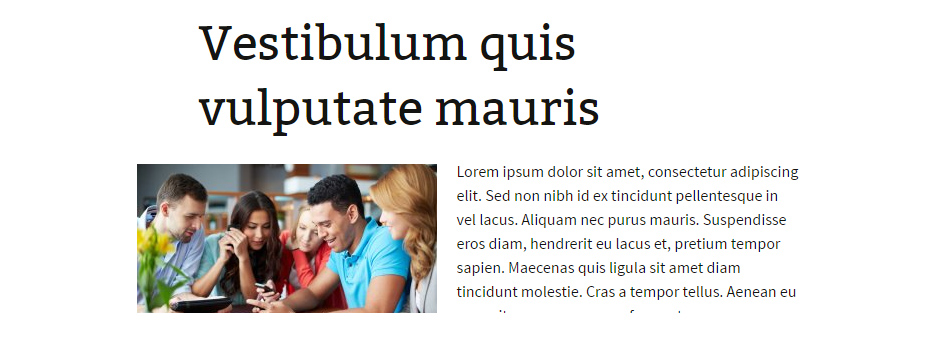
We managed to do all that just by adding our own custom function and removing our hooked actions.
Where This Technique Won't WorkIf there is no way for you to find the object of the class at all (either passed in as a variable in a hook or via some other method) then this technique will fail. A core part of Object Orientated Design principals says that there should always be a reference to the object so that it can be accessed, or failing that an easy way to load the object.
If this happens you can try the following steps (each more drastic and less recommended as we go down):
Hopefully after all this you should have a strong grasp on how to use WordPress's hook system to remove and adjust functionality inside your themes and plugins. If you're patient enough and can track down the hook, function and the class object you can remove and replace functionality as you see fit.
You might want to examine some of your currently installed plugins to see how developer friendly they are. Do they supply a wide range of hooks and filters? Are any of their values or settings explicitly hard coded in their theme or plugin? This information is important if you want to be able to extend and customize your website as you see fit.
For some further reading on the WordPress hook system check out Demystifying the WordPress Hook System by Agbonghama Collins.
Buy AutoTrafficRSS script now for $27 only!
We will send the script to your PayPal email within few hours,Please add FullContentRSS@gmail.com to your email contact.